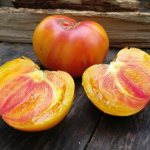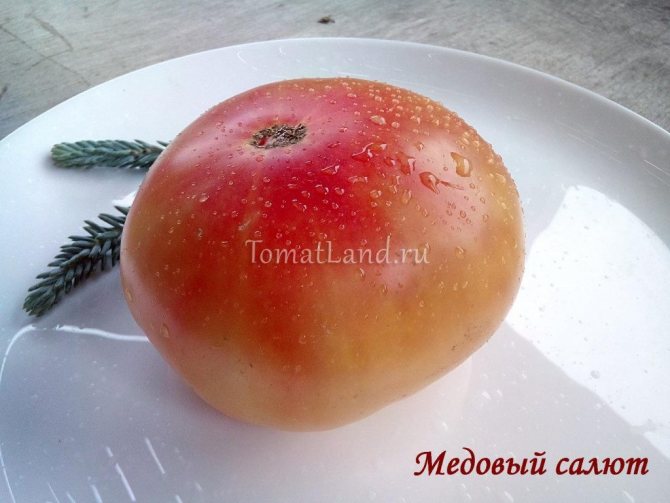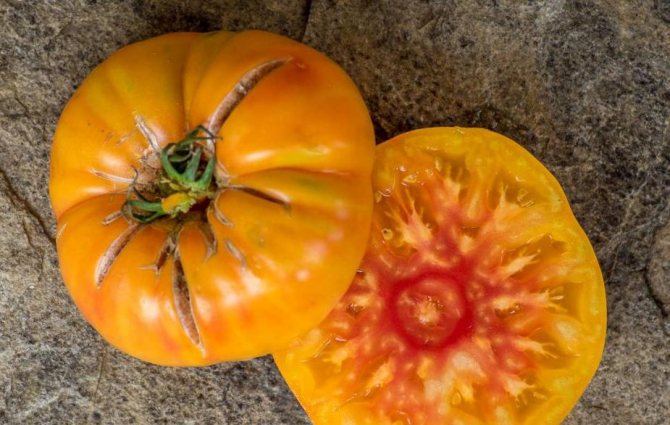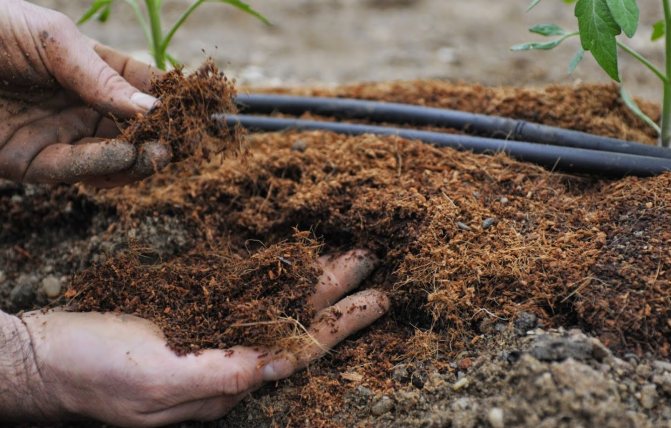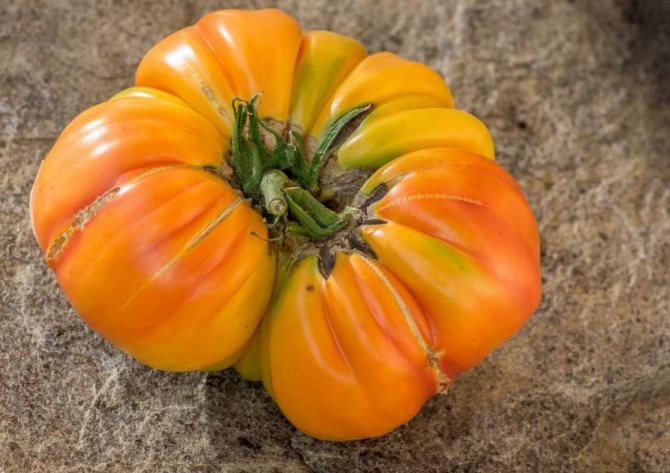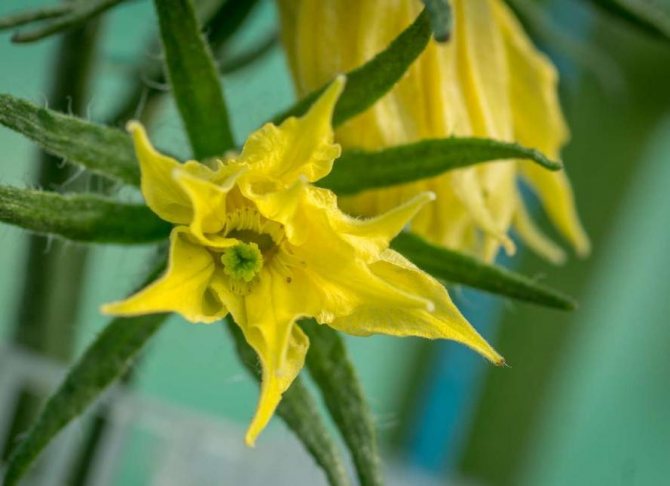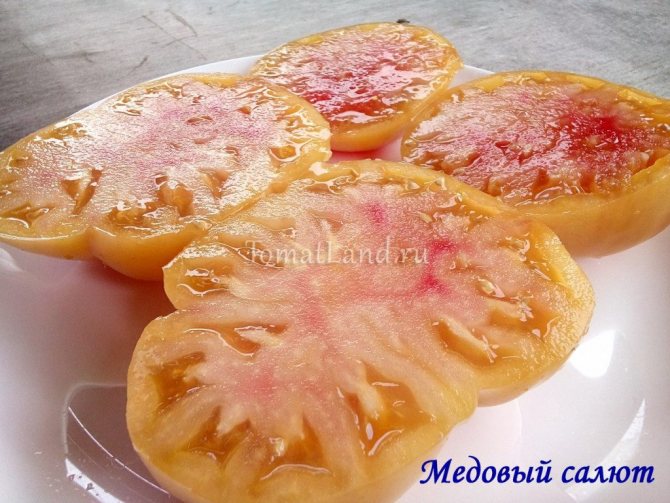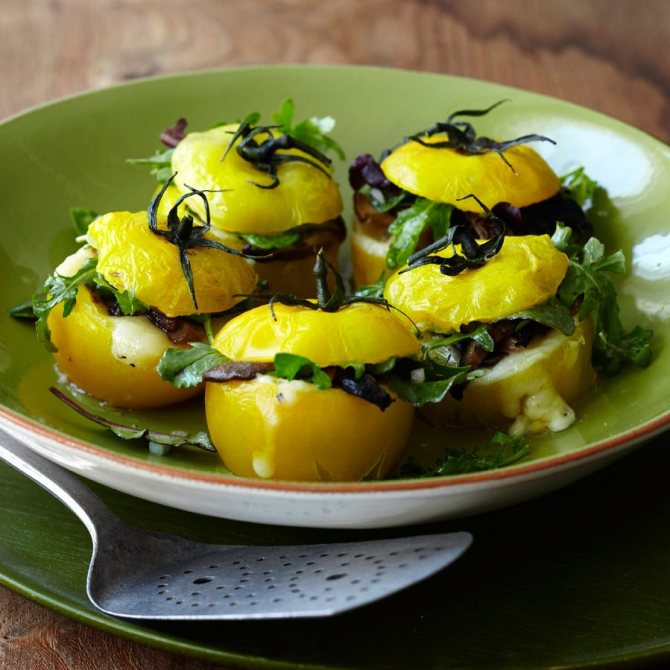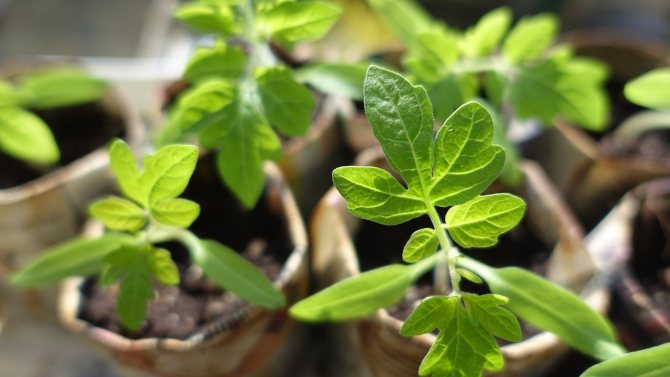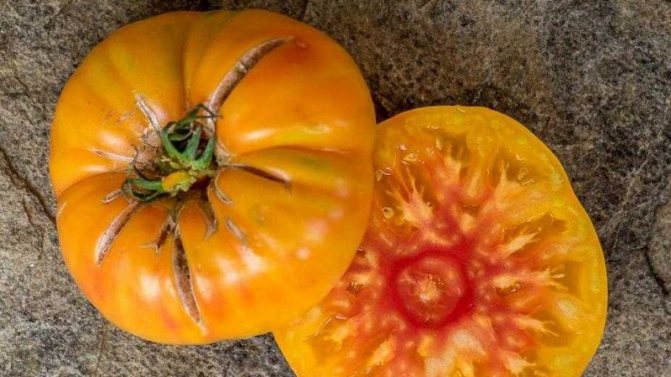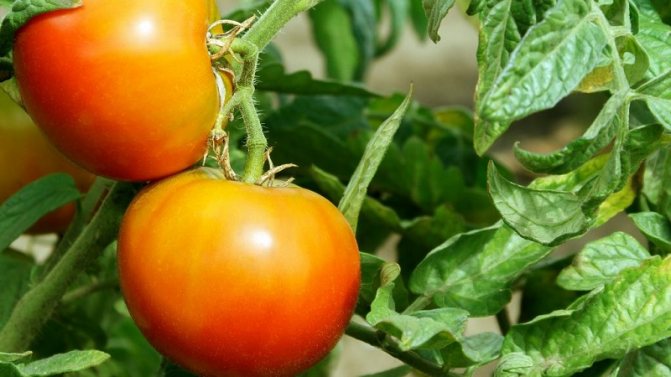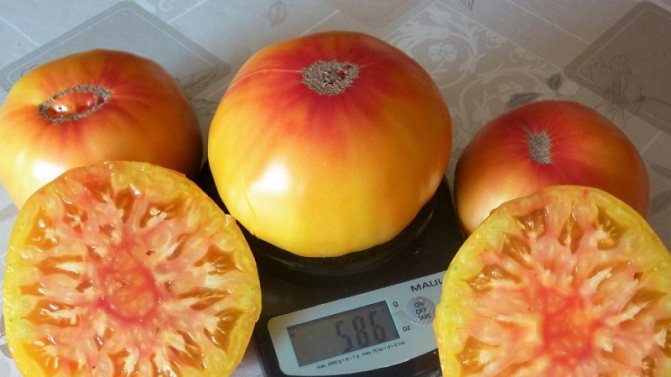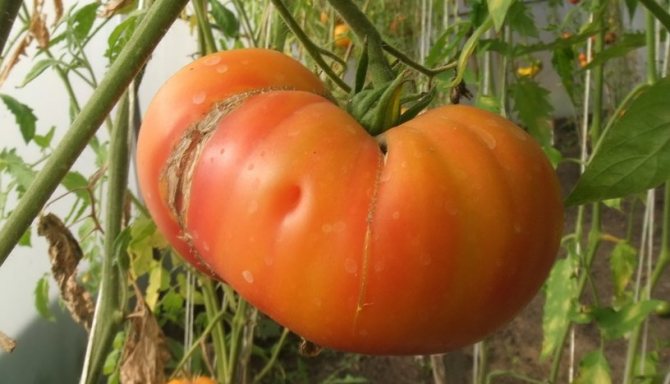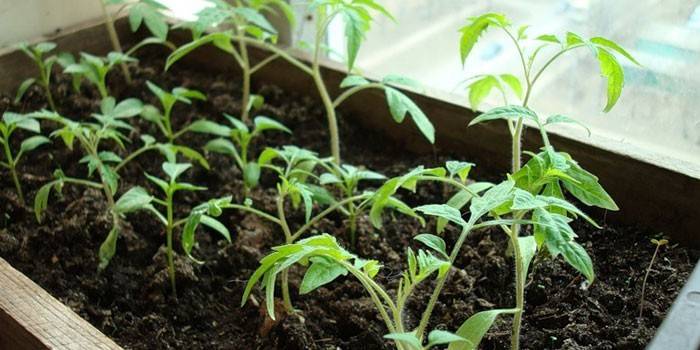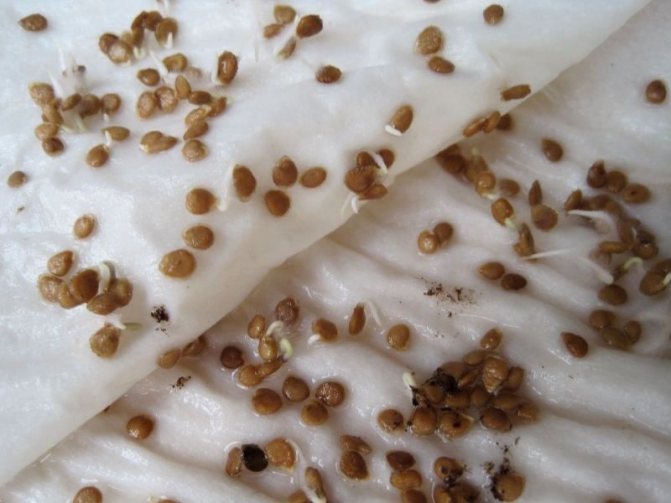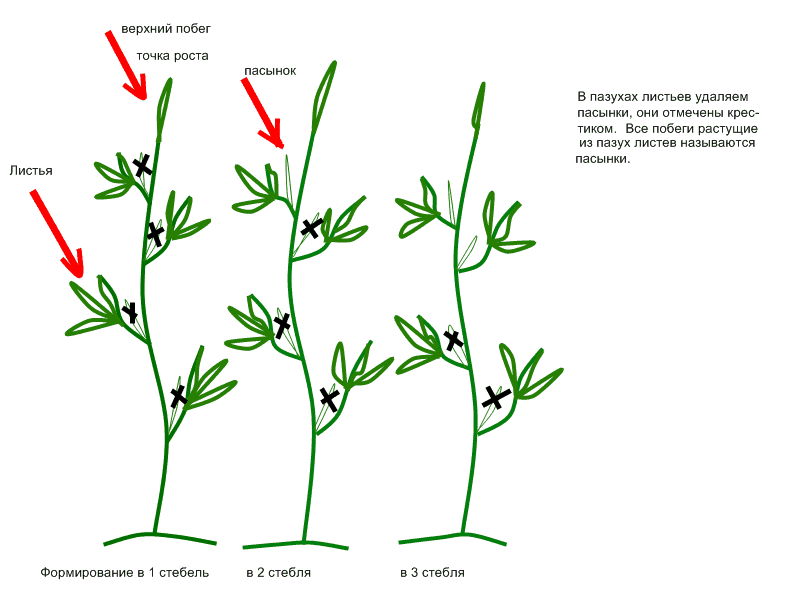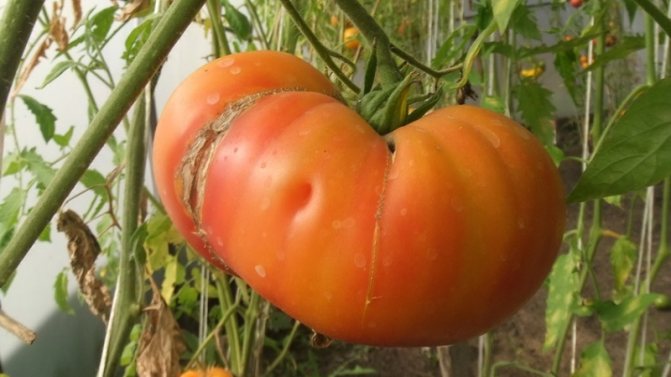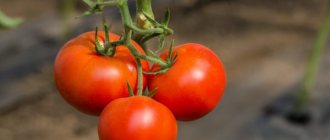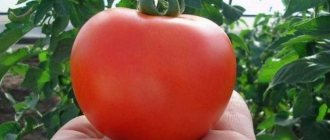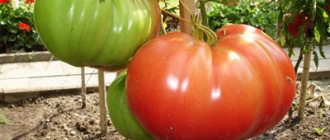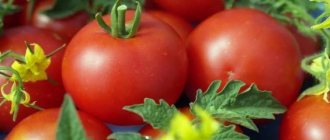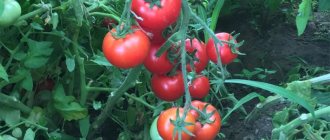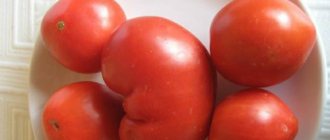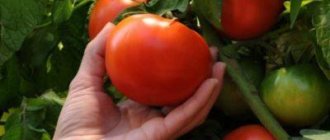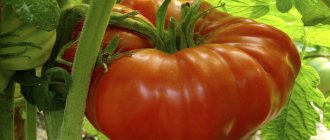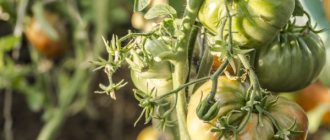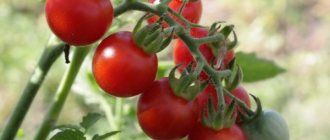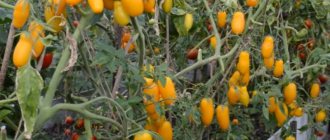Without colorful bright yellow tomatoes, the garden is empty and the ration of dishes on the table is not so interesting. Honey Salute is an excellent variety with above average productivity and has received many positive reviews. Among its important advantages are large-fruited, wonderful taste, disease resistance.
| Height | Pick-up location | Ripening terms | Fruit color | Fruit size | Origin | Fruit shape |
| Tall | Greenhouse, Open ground | Mid-season | Bicolor | Large | Variety | Flat-round |
Characteristics and description of the tomato variety Honey Salute
The bush reaches a height of 1.8 m, a large number of stepsons can grow at the bottom of the stem. This is a mid-late variety, that is, tomatoes must be harvested 4 months after the first sprouts appear. The number of leaves on the bush is average. The first inflorescence can grow over 9–12 leaves. It is advised to plant seedlings in greenhouses and tie them to a trellis.
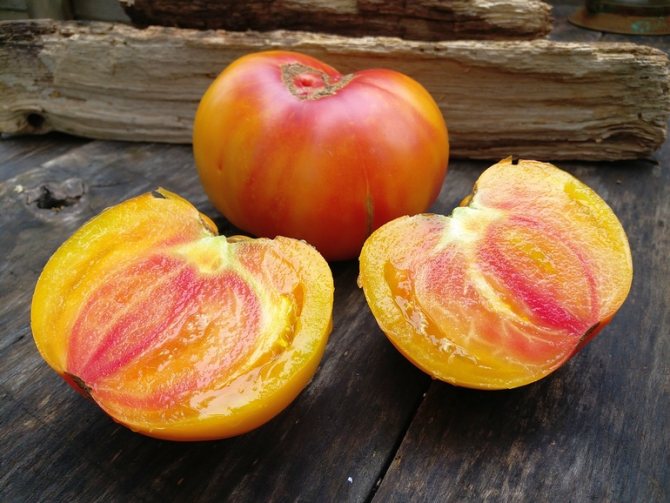
Tomato Honey Salute
Interesting. Tomato weighs 320-450 g. Productivity - up to 6.9 kg of fruits per 1 m².
The tomatoes are rounded, slightly flattened. Fruits are yellow with reddish spots. The golden flesh also has reddish and pinkish blotches. One fruit contains 5 seed nests. The taste is excellent. As one breeder wrote, "Welcome the breeding of such hybrids."
Fruits are eaten fresh, put in salads, tomato sauces are squeezed out.
Note! Tomatoes are stored in the refrigerator for up to 45 days.
Diseases and parasites
This sweet vegetable is regularly attacked by parasites and diseases. The most common attack is a whitefly and a tick that envelops the bush with cobwebs. To reduce their effect on this tomato variety, special colloidal solutions are used.
To protect the plant from fungal diseases, they regularly spray the tops with Bordeaux solution or a mixture of copper, and also ventilate the greenhouses.
Tomato Honey fireworks attracts attention not only by its appearance. It gained great popularity due to its taste. Thanks to its high levels of sugar and vitamins, it is great for baby food.
Planting seeds for seedlings
If the seed bag does not say that they are treated with a fungicide, a pink solution of potassium permanganate should be made. Pour the seeds into cheesecloth, place in potassium permanganate for half an hour, rinse and dry a little.


Seedling
Tomato Honey Giant: characteristics and description of the variety
If the package indicates that the seeds are disinfected, you need to pour them into plain water for several hours.
Note! The seeds can be sown in plastic cups, small peat pots, or a common box.
Lay expanded clay on the bottom with a layer of 2 cm, then lay out the earthen mixture, spill abundantly with water. Next, sprinkle the seeds at a distance of 4 cm. Then sprinkle with a layer of soil 1 cm. Cover the container with a film, put the planting in a warm and bright place. Every day it is necessary to raise the film in order to ventilate the crops, moisten the ground if it dries up.
When sprouts appear, you need to remove the film. When 2 true leaves appear on each seedling, they are dived into separate containers.
Description
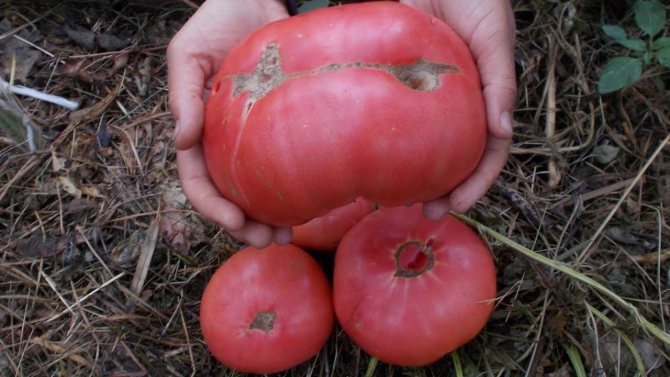

This variety is indeterminate, and when grown, the bush can reach 1.5 m. It should be tied up in time at the level of each brush so that large fruits do not break the stem.The plant is prone to the formation of stepchildren, which are removed, leaving 1-2. The culture is resistant to many diseases.
The fruits can be used as food 110 days after planting. They have a slightly flattened rounded shape, pink in color and reach 400 g. The largest tomatoes (up to 700 g) are obtained on the first cluster. There is a slight ribbing on the surface of the skin. There are not many seeds in them. The pulp is juicy, sweet.
Up to 10 kg of tomatoes can be harvested from each square meter of the garden. With proper cultivation, the yield can be doubled. The pulp has a high taste.
The grown fruits are used for fresh use, making salads, sauces, juices, first courses, pickling. The crop tolerates transportation well without losing its presentation.
Outdoor transplant and plant care
Growing seedlings in the house takes 65-70 days, then they should be transplanted into a greenhouse. The deadline is approximately May 15th. It is required to dig holes, observing an indent of 40 cm.Leave a distance of 60 cm between the rows.
Important! It is necessary to form a bush into 2 stems.
You will have to constantly cut off the stepsons who are below the first inflorescences. When 4-6 inflorescences grow on the stem, pinch its top.


In the open field
It is required to regularly water the crop abundantly, regularly combine watering with fertilizing with organic and mineral fertilizers. It is also advised to huddle the plants, this will stimulate root growth.
Care
According to the description, the Honey Salute variety needs regular feeding.
- The first is carried out two weeks after transplanting seedlings - with nitrogen-containing fertilizers.
- Complex feeding is carried out during the formation of ovaries, and during fruiting, phosphorus-potassium fertilizers are applied.
To increase yields and improve taste, it is recommended to feed more often - once every 2-3 weeks, using complex fertilizers.
Care also includes timely watering, loosening, weeding, mulching.
- Water it once a week - strictly at the root (or install a drip system).
- Loosening is done after watering, and then mulching is carried out.
- To grow large tomatoes, flower brushes are recommended to thin out.
- During ripening, the stems have to be tied up so that they do not fall under the weight of the fruit.
Honey tomatoes on video
If you have grown Honey tomatoes, please write whether you like them or not. What was the yield and taste of the fruit in your conditions? How do you rate the resistance of this variety to diseases? If possible, attach a photo of the entire bush or individual fruits grown by you to the commentary. Thank you!
Your reviews about the Honey tomato and additions to the description will help many gardeners evaluate this variety more objectively and decide whether to plant it or not.
Sources:
Testimonials
Honey - I liked the variety, fruitful, almost all are large enough.
Love
First impression: a large sweet tomato for food and processing. Seedling rating - 3, bush - 4+, fruit - 5, overall grade rating - 5.
Alyona
Grown in a greenhouse, but almost completely open on all sides. Plants are powerful, hassle-free. All the brushes were tied. The fruits are tasty, fleshy, pink. In seedlings, he behaved at 5+. Strong such trees with dark foliage of the usual type. It turned out to be medium late. In all respects, I liked the variety ... not in vain I wanted it badly.
Valentine
Taste quality on par with pink varieties. I did not notice anything honey. A variety exclusively for salad purposes. Requires more space. The plant is spreading. The optimal planting pattern is 50 * 60. Here the manufacturer did not lie. You need to plant no more than 4 bushes per square meter. I planted 40 * 60. Maybe that's why this variety did not please me.In general, this year in the Moscow region summer was abnormal. Everyone had problems with tomatoes. I judge by other varieties. Their productivity was better.
Algam
The yield is good, 3-4 kg of tomato can be removed from one bush. The variety is not whimsical, resistant to temperature extremes, and has a high immunity to diseases. It is better to tie the branches so that they do not break off, and not only the main stems, but also the brushes with fruits. Better to plant in a sunny location. The pulp is dense, fleshy, sweet. The skin is not thick, but firm. Delicious tomato juice turns out.
Keithkeller
Honey Tomato is a very good salad variety that fully justifies its name. Of course, it has analogues and even competitors, but so far Medovy remains quite popular with amateur gardeners in all regions of the country.
Agrotechnical cultivation
The nuances of growing these tomatoes include:
- it is necessary to sow seeds for seedlings in the first or second decades of March, and after the appearance of 3 real leaves, the seedlings should be sown in separate cups;
- seedlings are transplanted to a permanent place only when the soil warms up to a depth of 8-9 cm, and its temperature becomes at least 16-17 ° C;
- the irrigation regime is regular, as the topsoil dries out.
Tomato Honey Spas
When choosing a place for planting seedlings, you should remember the rules of crop rotation, do not grow them after other plants of the Solanaceae family. The best predecessors for tomatoes are zucchini, cucumbers, carrots, any varieties of cabbage, greens.
Bushes of this variety require binding and the formation of shoots. It is required to monitor the bushes during the ripening period of the fruits so that they do not bend or break, because it is almost impossible to save the broken part of the tomato.
Need to know! For tying, synthetic threads are used to avoid rotting shoots.
If these bushes are properly looked after, then the ripening tomatoes will be large, therefore, reliable supports are substituted under the fruit stems, or they are also tied to supports.
The Honey variety requires good lighting so that its fruits can gain sugar content, so it is important to choose a bright place, slightly shaded from the midday sun.
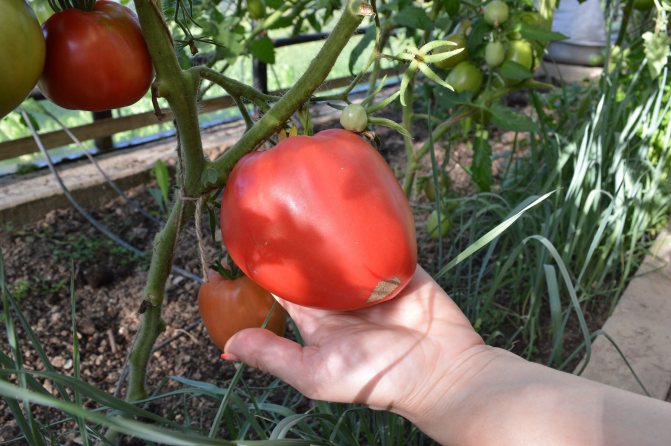

Honey tomato in the garden
For active growth and ripening of fruits, this vegetable plant requires more nutrients than other varieties of tomatoes. Therefore, during the period of growth and flowering, every 10 days, under the bushes of the Honey tomato, fertilizers containing potassium and phosphorus are applied, and during the period of ovary formation and ripening of fruits - complex mineral fertilizers.
Although this variety is highly resistant to the main diseases that damage tomatoes, and is practically not exposed to the invasion of "harmful" bugs, the condition of the above-ground part of the bushes should be monitored regularly.
The main diseases that summer residents who grow this variety have to face are associated with non-compliance with the rules for caring for honey tomato.
At all stages of the development of these tomato bushes, you need to monitor the irrigation regime, lighting, timely fertilization, regularly ventilate the premises in greenhouse conditions, and then the Honey tomato will not be susceptible to disease.
The main pests that can settle on tomato bushes are aphids, thrips, sawflies and nightshade miners. When pests appear, it is necessary to treat the affected parts of the plants with special preparations. You can buy them at any specialty store. The dosage and method of processing should be carried out in accordance with the instructions for use of the drug.
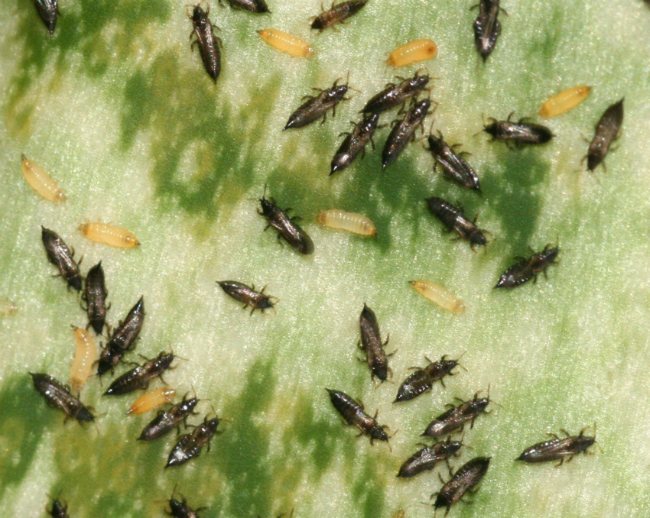

Thrips
Advantages and disadvantages
Vegetable growers thinking about growing the Honey Spas variety first study its pros and cons.


Positive characteristics include:
- resistance to drought and exposure to sunlight;
- resistance to low temperatures;
- attractive appearance;
- the possibility of growing on different types of soil;
- no special requirements for the soil;
- the ability to transport tomatoes over long distances without fear of violating their integrity;
- useful properties of a vegetable;
- pleasant taste;
- long storage period;
- resistance to cracking.
Attention! The variety is resistant to various diseases or parasites.
There are simply no significant disadvantages, but gardeners have to pay a lot of attention to pinching and garter, as the bushes grow quickly.
See also Features of growing tomato Raspberry ringing
Appearance
In appearance, ripe tomatoes of the Medovy variety are very beautiful. They are large, almost regular in shape: round, but flattened at the top and bottom. There are no significant flaws on the surface. The color depends on the degree of ripening and is transitional from dark pink to raspberry, it becomes even only at the very end, at first small stripes, spots, etc. are possible. It cannot be said that the variety is easy to recognize by its appearance: nowadays a lot is known tomatoes of a similar shape and color. And they all usually give the impression of excellent taste. In the case of honey tomato, like most analogues, this assumption is justified when tasting.
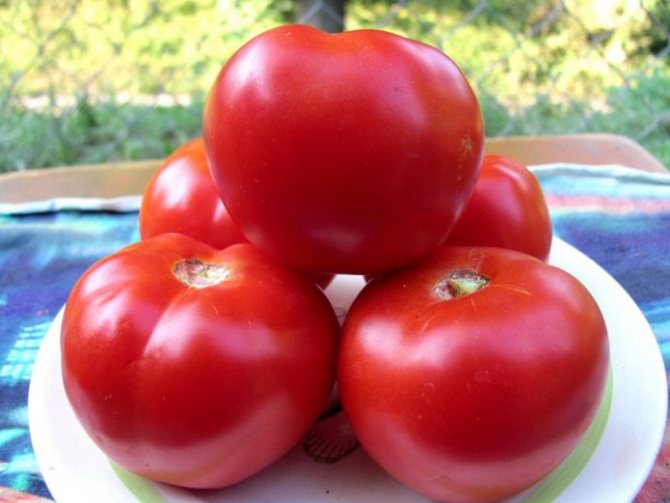

The fruits of the Honey tomato are even, almost regular in shape
The history of the creation of the variety
The "authors" of this variety are breeders from the agro, located in the city of Barnaul, engaged in breeding vegetable varieties that are resistant to the harsh climatic conditions of the Urals and Siberia. The tomato variety Honey was submitted for inclusion in the State Register in 2004. After testing this new variety, it was included in the State Register in 2007, and it was released for regions with harsh climatic conditions. This tomato is recommended for indoor and outdoor cultivation.
In the southern regions, these tomatoes grow well in garden beds, and in colder climates it is better to grow them in greenhouse conditions, where the yield of the variety will correspond to the declared one, and the fruits will grow to those described by the breeders.
Vegetable growers managed to appreciate the positive qualities of this tomato, and now in many farms you can find Honey variety bushes on the beds.
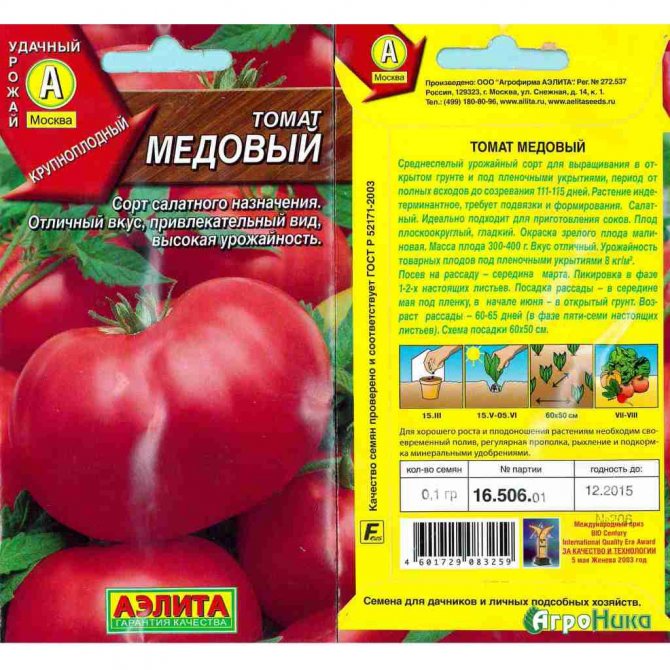

Tomato Honey Seeds

